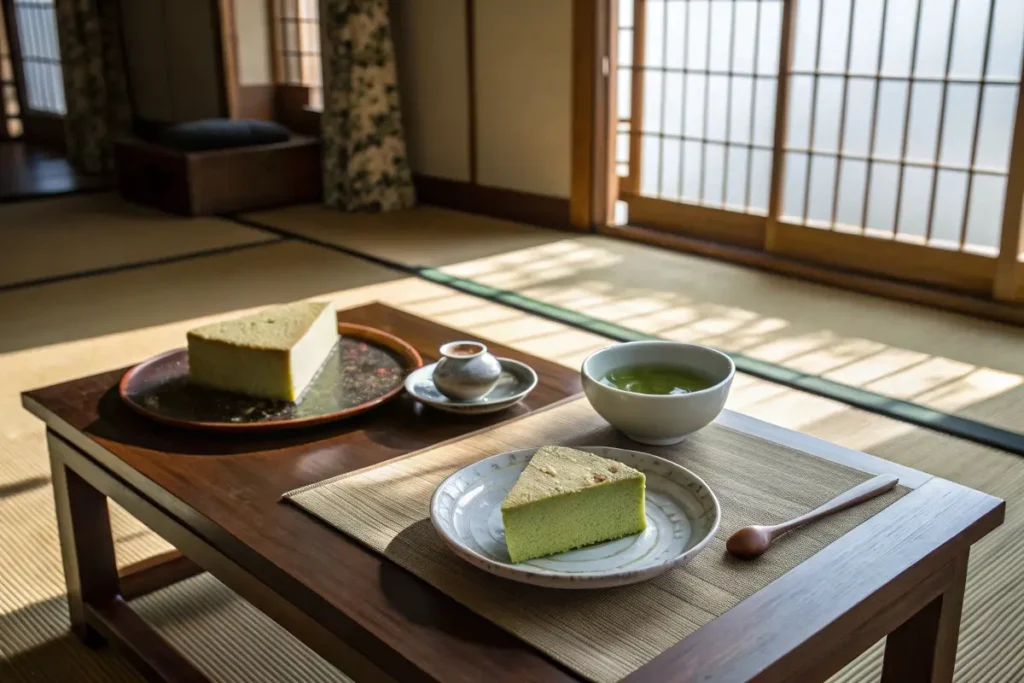Introduction
Japanese desserts enthrall the world with their balance of delicate sweetness, artistic presentation, and deep cultural roots. Traditional confections like wagashi have long complemented tea ceremonies, highlighting refined technique and seasonality. Meanwhile, modern patisseries put a Japanese spin on Western favorites—like soufflé cheesecakes and matcha-infused pastries—offering a fusion of flavors beloved in Tokyo and beyond.
Yet japanese desserts go far beyond mochi or sweet bean paste. You’ll encounter fruit jellies, shaved-ice creations, and airy sponge cakes that have become mainstays, not just in Japan but also in global dessert menus. If you’ve ever wondered what are popular Japanese desserts, what are the traditional sweets in Japan, or what is the most popular pastry in Japan, this comprehensive guide will illuminate the rich diversity behind the concept of Japanese sweets.
Craving deeper inspiration for your sweet repertoire? Discover step-by-step instructions in our Traditional Japanese Desserts Recipe collection, where mochi-making and green tea pastries come to life. Throughout this article, we’ll explore how Japanese desserts combine flavor, beauty, and tradition—resulting in confections that delight both the eyes and the palate.
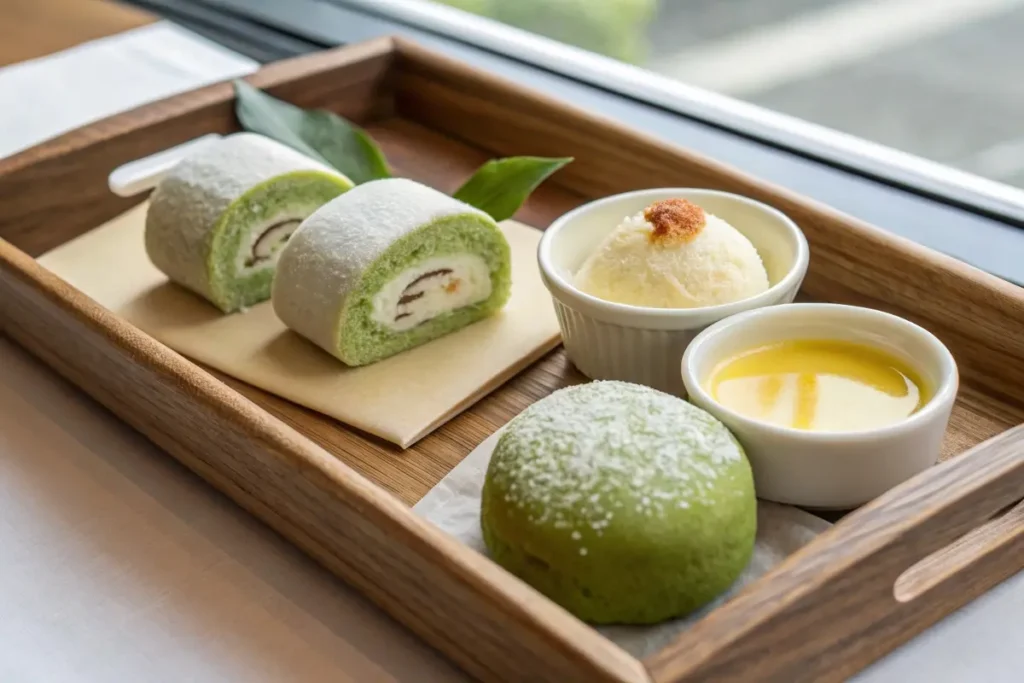
Defining Japanese Desserts
1. The Two-Fold World of Wagashi and Yōgashi
Japanese desserts fall into two broad categories:
- Wagashi: Traditional confections typically made from azuki beans, rice flour, and agar. These are often served during tea ceremonies or festivals.
- Yōgashi: Western-influenced pastries adapted to local palates—featuring less sugar, airy textures, and frequent use of matcha or sweet bean paste.
This dual identity allows Japanese desserts to constantly evolve, merging ancient techniques with modern flair.
2. Emphasis on Seasonal and Visual Elements
From cherry blossom–inspired sweets in spring to chestnut or sweet potato–based treats in autumn, Japan’s dessert makers highlight the seasons. Presentation also matters: small, perfectly shaped confections reflect nature’s colors—pink for sakura, green for fresh matcha, brown or gold for chestnuts.
Minimalist Approach: Many Japanese dessert recipes rely on minimal sugar, accentuating the natural flavor of matcha, azuki beans, or fresh fruit. This subtlety stands in contrast to heavily frosted Western cakes, offering a balanced, refreshing sweetness.
3. Healthier Perception
Are japanese desserts automatically healthier? Not always, but wagashi’s reliance on plant-based ingredients (beans, rice, agar) can lead to lower fat and moderate sweetness. Even modern pastries, though indulgent, prioritize fluffiness over heavy cream, giving them a lighter profile. For instance, the famed Japanese soufflé cheesecake feels airy despite being quite rich.
4. Commonly Used Ingredients
- Azuki Beans: Boiled and sweetened to create anko paste. Fills daifuku, dorayaki, or taiyaki pastries.
- Mochiko/Rice Flour: Key to mochi or dango, delivering a chewy, pleasing texture.
- Matcha: Powdered green tea for color and subtle bitterness in cakes, cookies, jellies.
- Kanten (Agar): A seaweed-based gelling agent used in yokan or mizu yokan—firmer than gelatin, suitable for vegetarian sweets.
- Sweet Potatoes/Kabocha: Often used in pies or yokan, harnessing their natural sweetness and creamy texture.
To see an easy savory-sweet combination, check out our Mashed Japanese Sweet Potato Recipe. Though mostly a side dish, sweet potatoes are a prime dessert ingredient—when combined with sugar or condensed milk, they transform into pies, custards, or mochi fillings.
5. Popular Tokyo Innovations
Tokyo’s dessert scene constantly reinvents classics, offering taiyaki stuffed with ice cream or macha tiramisu parfaits. Gimmicky or not, they maintain the principle of modest portion sizes and balanced flavors. Tourists flock to these inventive sweets, making them “must-try” items. If you wonder what is a popular dessert in Tokyo, these playful updates on standard recipes will likely dominate your list.
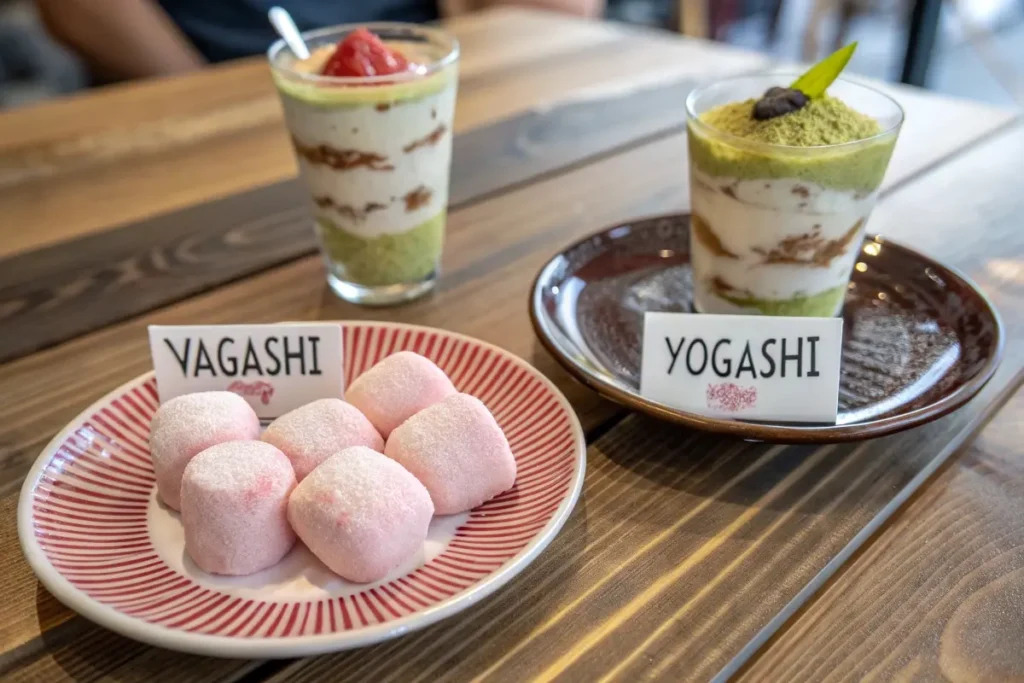
Popular Desserts and Sweets
1. Wagashi Highlights
- Daifuku
- Essentially mochi stuffed with sweet bean paste. Some versions add fresh fruit like strawberry daifuku (ichigo daifuku) for a fresh twist.
- Dorayaki
- Two soft pancakes sandwiching anko. Beloved by children and anime fans, easy to find in convenience stores or wagashi shops.
- Taiyaki
- A fish-shaped waffle pastry typically filled with anko or custard. Street vendors often customize fillings—chocolate, matcha cream, or sweet potato paste.
- Yokan
- A gelled sweet made from red bean paste and agar, cut into blocks. Mizu yokan (water yokan) is more delicate and often chilled in summer.
2. Modern Pastry Staples
- Japanese Cheesecake
- Known for its soufflé-like texture—airy, jiggly, and gently sweet. A hallmark of “less is more” in sugar usage.
- Matcha Roll Cake
- A sponge cake rolled with whipped cream, tinted green by matcha. The mild bitterness of matcha offsets the sweetness of the cream.
- Soufflé Pancakes
- Fluffy towers created by whipping egg whites into the batter. Often served with minimal syrup or fruit, letting the airy texture shine.
3. Fruit-Based Refreshers
Mizu Shingen Mochi (Raindrop Cake): A mild, transparent jelly shaped like a water droplet, served with roasted soybean flour (kinako) and brown sugar syrup (kuromitsu). This ephemeral dessert underscores Japanese aesthetics—fresh, fleeting, and visually captivating.
Kakigori (Shaved Ice): In summer, shaved ice drenched in flavored syrups (like matcha, yuzu, or strawberry) plus toppings like sweet beans. Some shops offer all-natural syrups or condensed milk options. The idea: sweet respite from heat without an overly heavy dessert.
4. Purin and Custards
Purin is a flan-like custard that stands as a household staple, both homemade and store-bought in cups. Typically, it’s a simple blend of eggs, milk, sugar, and caramel sauce. The lightly sweet nature makes it a popular comfort dessert.
5. Hybrid Creations and Seasonal Delights
Japan embraces limited-time treats, from sakura mochi in spring to kuri (chestnut) mont blanc in autumn, ensuring each season brings fresh dessert ideas. Even Western confections get a local spin: think matcha tiramisu, anko-filled croissants, or sweet potato tarts.
For comprehensive instructions and variations, see our Japanese Dessert Recipes guide. If you desire simpler or easy japanese desserts, you’ll find basic mochi kits or fruit jellies that require minimal technique. Meanwhile, advanced enthusiasts can tackle intricately shaped wagashi or layered cakes—perfect for showcasing skill at gatherings.
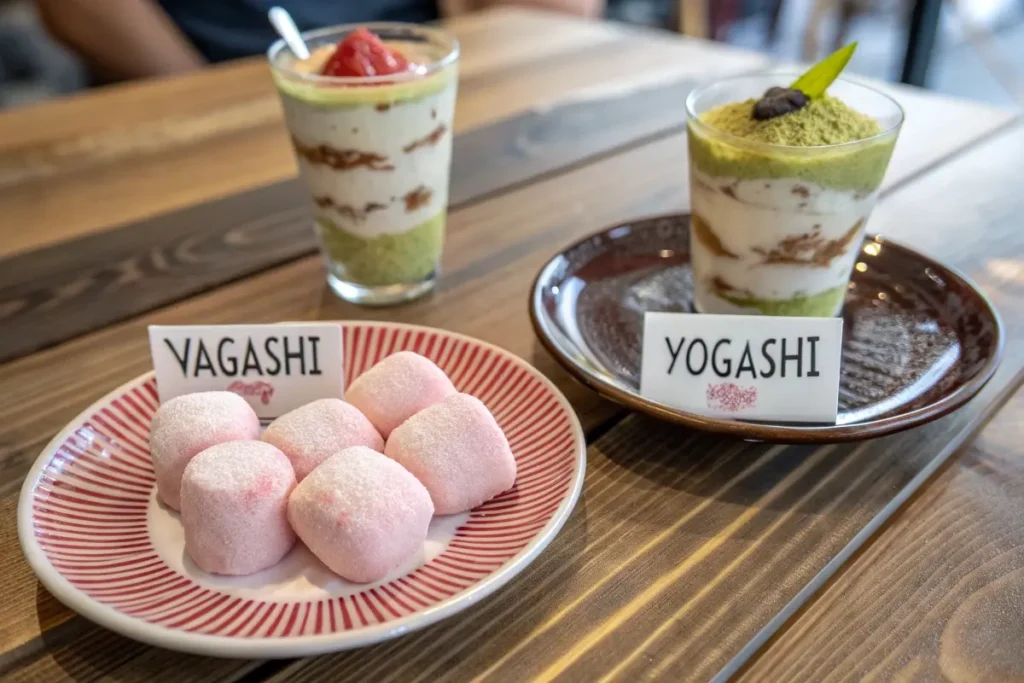
History and Examples: Japanese Desserts
1. Early Sweet Influences
Before refined sugar, Japanese confections primarily used honey, mochi, or fruit-based sweeteners. Religious rites (like those at shrines) or special celebrations often demanded symbolic sweets—mochi offerings or specific shapes representing good fortune. Over time, sugar trade led to the creation of more elaborate wagashi during the Edo period (1603–1868). Wagashi artisans refined techniques, shaping confections to reflect seasonal flowers, birds, or natural motifs.
2. Meiji Western Adaptations
The Meiji Restoration (1868) launched widespread modernization. Western desserts like sponge cakes, custards, and chocolates landed in Japan. Local pastry chefs experimented, marrying them with matcha, red bean paste, or rice flour. The result: new categories like castella (from Portuguese influence), gradually evolving into modern favorites such as jiggly cheesecakes or airy chiffon cakes.
3. Post-War Boom and Convenience
In the late 20th century, Japan’s economy soared, fueling an explosion of dessert shops. Conbini (convenience stores) carried single-serve parfaits, cream puffs, or cakes in plastic packaging—affordable and easily accessible. Television cooking shows and print magazines popularized home baking, nudging more families to try Western-inspired sweets at home.
Cultural Milestones: The shift from purely local wagashi to an integrated dessert scene gave birth to iconic modern pastries. Think of the swiftly rising phenomenon of matcha-flavored everything: from cookies to ice cream. Meanwhile, wagashi makers upheld traditions, ensuring mochi-based sweets remained vital to festivals like Hinamatsuri (Girls’ Day) or New Year’s celebratory spread.
4. Global Influence and Future
Today, Japanese desserts attract global fans. Tokyo’s dessert parlors lure tourists with neon-lit mochi donut shops or flamboyant fruit sandwiches. Social media amplifies new fads—like super-fluffy pancakes or towering parfaits. Western brands also collaborate with Japanese experts, presenting matcha-laced variants of standard products.
For a solid introduction to older, time-tested sweets, read our Traditional Japanese Desserts Recipe. It details how mochi pounding or anko creation remain cherished, bridging ancient ceremonies with modern delight. The synergy of tradition and adaptation ensures japanese desserts stay dynamic—forever reinterpreting flavors, designs, and techniques to thrill sweet-tooths worldwide.
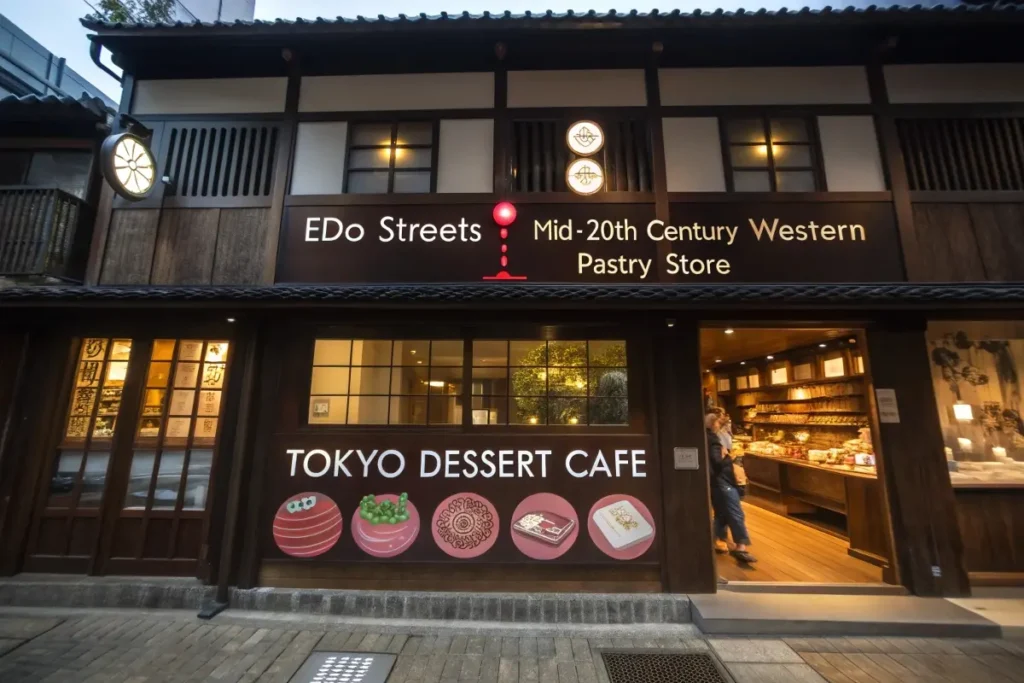
Practical Examples/Use Cases
1. Home Baking and Entertaining
Scenario: You want to host a casual dinner party, finishing with a Japanese-themed dessert.
- Approach: Prepare a batch of matcha roll cake or simpler dorayaki. For the latter, two pancakes plus sweet bean paste create an easy, shareable sweet.
- Outcome: Guests appreciate a cultural twist and the subtle sweetness stands out from typical Western cakes.
2. Cafés with a Twist
Scenario: A small business café aims to diversify its dessert menu.
- Approach: Introduce a matcha latte cake, a fruit-based anmitsu jelly cup, and a mochi doughnut. Market them as “light yet flavorful.”
- Benefit: Customers seeking unique experiences or lighter sweet alternatives frequent the café, generating buzz.
3. Gift Culture
Scenario: In Japan, bringing sweets to a host’s home or as a souvenir is common.
- Approach: Purchase beautifully boxed wagashi sets—like a variety of mochi or yokan slices. Some shops even craft confections shaped seasonally.
- Result: Gift recipients sense the thoughtfulness behind artisanal packaging and curated flavors, reflecting Japanese omiyage tradition.
4. Hands-On Workshops
Scenario: A local cultural center offers a “Japanese dessert weekend class.”
- Approach: Participants learn mochi-making, anko preparation, or shaping nerikiri (moldable wagashi). Emphasis on aesthetics, minimal sugar, and fresh produce.
- Value: Students appreciate the skill behind each sweet and feel a cultural connection. Some may replicate recipes at home, fueling dessert creativity.
For an easy home experiment bridging savory and sweet, consider referencing our Japanese Chicken Fried Rice Recipe for the main course and following it with a small mochi or fruit-based dessert. This synergy of a satisfying meal plus a modest sweet treat underscores how japanese desserts can seamlessly fit into varied contexts—from everyday dining to special events.
FAQs
1. What are popular Japanese desserts?
Mochi (in numerous forms like daifuku) and dorayaki often top the list. Modern hits include soufflé pancakes and matcha tiramisu. For a broader sense of variety, check out conbini dessert aisles, brimming with puddings (like purin), crepes, and mini cakes.
2. What are the traditional sweets in Japan?
Wagashi is the umbrella term for traditional sweets, typically built around rice flour, bean paste, or agar. Examples include daifuku, yokan, dango, and ohagi. They frequently appear during festivals or tea ceremonies, valued for subtle flavors and symbolic shapes.
3. What is the most popular pastry in Japan?
Soufflé pancakes have surged in global popularity for their iconic fluffiness. Another contender is Japanese-style cheesecake, known for its jiggly, featherlight texture. Both reflect local tastes: less sugar, airy mouthfeel, and often served in smaller portions.
4. What is a popular dessert in Tokyo?
Tokyo’s dessert scene constantly evolves. Taiyaki stuffed with matcha ice cream, flamboyant parfaits loaded with fruit or mochi, and specialty doughnuts with Japanese flavors are trending. Upscale patisseries also showcase seasonal Mont Blanc variations or creative mousse cakes.
5. Are Japanese desserts typically low in sugar?
Many are milder than Western desserts but not strictly “low sugar.” Traditional wagashi rely on minimal refined sugars and emphasize natural sweetness from beans or fruit. Modern pastries might use less sugar than their Western counterparts, yet it varies by recipe or brand.
6. How do I begin exploring Japanese sweets at home?
Start with simpler items, like mochi or dorayaki. Tools needed include a whisk for matcha-based goodies, glutinous rice flour, and anko paste. Our Japanese Dessert Recipes covers step-by-step approaches. Gradually progress to layered cakes or delicate nerikiri wagashi as your skills improve.
7. Can I find healthy or vegan versions?
Yes. Many wagashi are inherently vegan or use fewer animal products. Substituting dairy with plant-based alternatives—like soy or coconut milk—further accommodates vegan diets. For health-conscious variations, using minimal sugar or sweet potatoes as a base can help. Always verify ingredients if you have dietary restrictions.
Conclusion
From humble wagashi shaped centuries ago to modern cafes showcasing matcha tiramisus and jiggly cheesecakes, japanese desserts radiate both cultural heritage and inventive flair. Whether you’re sampling a sweet bean–filled mochi or marveling at the airy texture of a soufflé pancake, you’ll find an overarching emphasis on balanced sweetness, artistry in presentation, and seasonal nuance. These traits make japanese desserts distinct and unforgettable—much more than mere sugary confections.
Eager to try making them at home? Start with basic mochi or simpler recipes like dorayaki. Or, if you’re craving a more elaborate challenge, attempt crafting a layered matcha roll cake or learning the fine shaping techniques of nerikiri wagashi. You’ll soon discover the joy of combining traditional techniques with modern flavors.
For more step-by-step guidance on popular and lesser-known sweets, visit our Traditional Japanese Desserts Recipe. You’ll learn how to transform everyday ingredients—like sweet potatoes, beans, or matcha—into memorable treats. With each creation, you carry on a tradition that blends precision, respect for nature, and a dash of culinary whimsy, ensuring that the future of japanese desserts remains bright and delicious.
